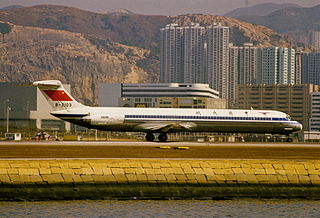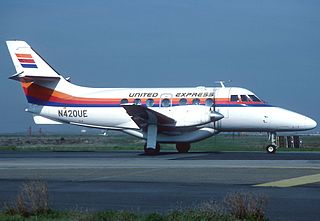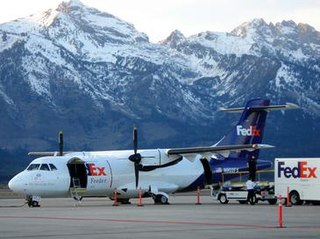In aviation, a go-around is an aborted landing of an aircraft that is on final approach. A go-around can either be initiated by the pilot flying or requested by air traffic control for various reasons, such as an unstabilized approach or an obstruction on the runway.

The Mitsubishi MU-2 is a Japanese high-wing, twin-engine turboprop aircraft with a pressurized cabin manufactured by Mitsubishi Heavy Industries. It made its maiden flight in September 1963 and was produced until 1986. It is one of postwar Japan's most successful aircraft, with 704 manufactured in Japan and San Angelo, Texas, in the United States.

American Airlines Flight 383 was a nonstop flight from New York City to Cincinnati on November 8, 1965. The aircraft was a Boeing 727, with 57 passengers, and 5 crew on board. The aircraft crashed on final approach to the Cincinnati/Northern Kentucky International Airport located in Hebron, Kentucky, United States. Only three passengers and one flight attendant survived the crash.

Scandinavian Airlines System Flight 933 was a scheduled international flight from Denmark to the United States that on January 13, 1969, crashed into Santa Monica Bay at 19:21, approximately 6 nautical miles (11 km) west of Los Angeles International Airport (LAX) in California, United States. The crash into the sea was caused by pilot error during approach to runway 07R; the pilots were so occupied with the nose gear light not turning green that they lost their situation awareness and failed to keep track of their altitude. The Scandinavian Airlines System (SAS) aircraft had a crew of nine with 36 passengers, of whom 15 died. The flight originated at Copenhagen Airport, Denmark, and had a stopover at Seattle–Tacoma International Airport, where there was a change of crew.

Czechoslovak Airlines Flight 001 was an Ilyushin Il-18B four engine turboprop airliner, registered OK-NAB, which was operating as a scheduled domestic passenger flight from Prague's Ruzyně airport to Bratislava-Ivanka Airport, both in Czechoslovakia, which crashed into the Zlaté Piesky Lake while attempting to land in Bratislava on July 28, 1976. All 6 crew members and 70 out of 73 passengers died.

Southwest Airlines Flight 1455 was a scheduled passenger flight from McCarran International Airport, Las Vegas, Nevada to Burbank-Glendale-Pasadena Airport, Burbank, California, that overran the runway during landing on March 5, 2000. The aircraft, a Boeing 737-3T5, registration N668SW, came to rest on a city street adjacent to a gas station. The National Transportation Safety Board found that the incident was due to the pilots attempting to land with excessive speed. They also found that the air traffic controller placed them in a position from which their only option was a go around. Two of the flight attendants were seriously injured, and there were many minor injuries. As a result of the incident, the airport installed an Engineered Materials Arrestor System (EMAS) at the east end of the incident runway.
A hard landing occurs when an aircraft or spacecraft hits the ground with a greater vertical speed and force than in a normal landing.

China Eastern Airlines Flight 5398 (MU5398) was a McDonnell Douglas MD-82 airliner from Shenzhen's Bao'an International Airport to Fuzhou Yixu Airport in Fujian, China. On October 26, 1993, it crashed on approach to Fuzhou Yixu Airport. The aircraft overran the runway while landing in heavy rain and high winds. Two of the 80 passengers and crew on board were killed.

Iberia Airlines Flight 610 was a scheduled domestic passenger flight from Madrid to Bilbao, Spain. On 19 February 1985, a Boeing 727-200 operating the flight crashed into a television antenna on the summit of Mount Oiz in Biscay near Bilbao. All 141 passengers and 7 crew on board died. The crash is the deadliest aviation disaster in both Basque Country and Iberia history.

Northwest Airlink Flight 5719 was a flight from Minneapolis-Saint Paul International Airport to International Falls Airport in International Falls, Minnesota with a scheduled intermediate stop at Chisholm-Hibbing Airport in Hibbing, Minnesota. On December 1, 1993, the Jetstream 31, operated by Express Airlines II as Northwest Airlink, collided with a group of trees in a forest during final approach to Hibbing, and crashed into two ridges just east of the airport, killing all sixteen passengers and the two pilots on board.

United Express Flight 2415 was a regularly scheduled flight from Seattle to Pasco, Washington, operated using a BAe Jetstream 31. On December 26, 1989, Flight 2415 crashed while attempting to land at Pasco's Tri-Cities Airport, killing both pilots and all four passengers aboard.

Northwest Airlink Flight 2268 was a commuter flight between Cleveland-Hopkins International Airport in Cleveland, Ohio, and Detroit Metropolitan Wayne County Airport in Romulus, Michigan, just outside Detroit. The flight was operated by Fischer Brothers Aviation, doing business as Northwest Airlink, and was operated by a CASA C-212 aircraft. On March 4, 1987, the plane crashed while attempting to land. Nine of the 19 passengers and crew on board were killed in the accident.

Aeroflot Flight 721 was a scheduled domestic passenger flight between Moscow and Yuzhno-Sakhalinsk in the Russian SFSR. On Wednesday, 2 September 1964, the aircraft flying this route, an Ilyushin Il-18V, crashed into the side of a hill on approach to Yuzhno-Sakhalinsk, killing 87 of the 93 people on board. At the time of the accident it was the deadliest Il-18 crash and the deadliest aviation accident on Russian soil.

Aeroflot Flight 601 was a scheduled Soviet domestic passenger flight from Arkhangelsk to Leshukonskoye, operated by Aeroflot. The Antonov An-24RV crashed on 24 December 1983 during approach to Leshukonskoye due to pilot error. Five out of forty-nine people on board survived the accident. Pilot error was cited as the cause of the accident.

Delta Air Lines Flight 723 was a Douglas DC-9 twin-engine jetliner, operating as a scheduled domestic passenger flight from Burlington, Vermont to Logan International Airport in Boston, Massachusetts, with an intermediate stop in Manchester, New Hampshire. On July 31, 1973 at 11:08AM, while on an ILS instrument approach into Logan in low clouds and fog, the aircraft descended below the glidepath, struck a seawall with a landing gear and crashed, killing all but two of its 89 occupants. Both survivors later died of their injuries.

Trans-Colorado Airlines Flight 2286 was a scheduled domestic passenger flight from Denver, Colorado, to Durango, Colorado, operated for Continental Express by Trans-Colorado Airlines. On January 19, 1988, Flight 2286 crashed onto terrain near Bayfield, Colorado, while on approach to Durango-La Plata County Airport. Out of the 17 people on board, 9 were killed, including both crew members.

Aeroflot Flight 2808 was a scheduled domestic passenger flight from Mineralnye Vody to Ivanovo, both in Russia, with a stopover in Donetsk, Ukraine on 27 August 1992. While attempting to land at Ivanovo airport the Tupolev Tu-134 crashed into a group of buildings in the village of Lebyazhy Lug. Investigators determined the cause of the accident was errors made by the crew and the air traffic controller. There were no fatalities on the ground but all 84 people on board the flight died in the crash.

Aeroflot Flight 20 was a scheduled domestic passenger flight from Moscow to Alma-Ata with a stopover in Omsk that crashed in low visibility conditions on 4 January 1965, killing 64 of the 103 people on board.

Empire Airlines Flight 8284 was a cargo flight operated by Empire Airlines for FedEx Feeder between Fort Worth Alliance Airport and Lubbock Preston Smith International Airport, Texas. On 27 January 2009, it crashed on final approach to its destination. Both crew members survived with minor injuries but the aircraft was written off.

Aeroflot Flight 51 was a scheduled domestic passenger flight operated by an Antonov An-24 that crashed on approach to Liepāja International Airport on 30 December 1967, resulting in the death of 43 of the 51 people on board. The investigation revealed the cause of the accident to be pilot error.

















